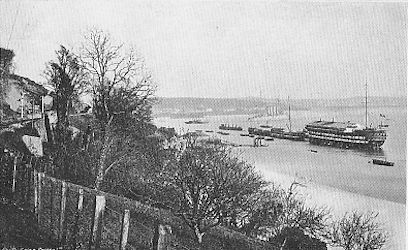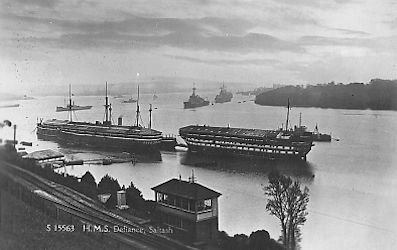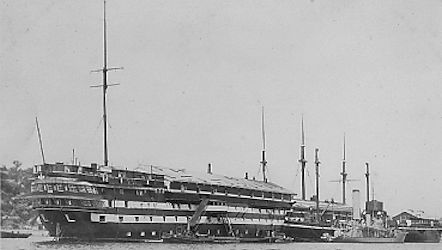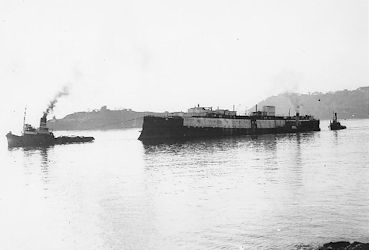|
OLD DEVONPORT
. UK |
||
|
© Brian
Moseley, Plymouth Webpage created: August 11, 2018 Webpage updated: June 10, 2020 |
||
|
ROYAL NAVAL TORPEDO SCHOOL
HMS "Defiance", the Royal Naval Torpedo
School, was pleasantly situated The ninth ship named HMS "Defiance" was launched at Pembroke Dock in south Wales on March 27th 1861. She was immediately declared as obsolete following the introduction of ironclad ships and was towed to Plymouth, where she was placed in the reserve fleet.
HMS "Defiance" even had its own Halt on the main railway
line between Plymouth Over twenty years later, on April 22nd 1883, orders were given for her to be stripped of her machinery and on December 13th 1884 she was commissioned as the new Royal Naval Torpedo School at Devonport. She was moored in the Hamoaze off Wearde Quay by the entrance to the river Lynher, just below Saltash. This river was very useful as part of the curriculum in this school was the firing of live explosive submarine mines and Whitehead Torpedoes and this was done up the river. In the middle of 1886 the sloop "Perseus" (built in 1861) was moored just ahead of the "Defiance", to which she was connected by a bridge. She was used almost entirely for mining work, the mines being kept on board. Early in 1904 she was renamed "Defiance II". She appears to have been replaced in 1921 by the "Spartan", as noted below. In 1905 the School was expanded by the addition of the corvette "Cleopatra" (1879), which became an overflow ship. She was named "Defiance III" in January 1922 and survived until July 1931, when she was sold.
A view of the Royal Naval Torpedo School from the Hamoaze. Then in 1907 the obsolete 2nd class cruiser "Spartan" was added as a tender. She was renamed "Defiance II" in August 1921 and served until she was sold on June 26th 1931. From October 1920 the frigate "Inconstant" (1868), which had been a part of the "Impregnable" since 1906, became an extra accommodation hulk and took the name "Defiance IV" in January 1922. The four vessels comprising HMS "Defiance" were found to be unserviceable and the Torpedo School was closed on October 10th 1930 and training transferred to Portsmouth. On Monday October 13th 1930, HMS "Defiance I" was towed from her mooring at Wearde on the Saint Germans River to Number 6 buoy in the Hamoaze. Although the weather was perfect for this operation, four tugs, the "Atlas", "Pert", "Camel" and Industrious", were detailed for the duty. At 7am on Tuesday October 14th she was moved into Number 3 Basin in the Royal Dockyard where between then and October 21st she was joined by the other ships of the establishment. The whole operation was under the command of Mr Crowther of the Captain of the Dockyard's Department. It was reported at the time that also inside the Royal Dockyard were the old HMS "Andromeda", formerly part of HMS "Impregnable" and the former submarine depot ship HMS "Vulcan". The latter was to be reconditioned and would form part of the new HMS "Defiance" along with "Defiance IV", the former HMS "Inconstant". She in turn became "Defiance II" in December 1930. The ship's company, who remained aboard while it was in the Royal Dockyard, was granted Christmas leave from December 22nd 1930 until January 7th 1931. The new establishment, appointed on January 20th 1931, consisting of the former HM Ships "Andromeda", "Defiance IV" (ex-"Inconstant") and "Vulcan" were moored off Wilcove between January 17th and February 4th 1931. This new location was necessary because the replacement vessels needed a greater depth of water than existed at the former mooring. The Torpedo School was reopened at a special ceremony on Monday February 9th 1931, when the Honourable Alice Brand, sister of Admiral the Honourable Sir Hubert Brand, the Commander-in-Chief, Devonport, closed the switch which unveiled the nameplate of HMS "Defiance" on board the former HMS "Andromeda", making her the eleventh Royal Navy vessel to carry that name. The letters making up the name and the teak backboard both came from the previous ship of that name. Amongst those present at the ceremony, in addition to the Commander-in-Chief, were Lieutenant-Colonel and Mrs Drury, the Mayor and Mayoress of Saltash; Captain Sir Lionel A D Sturdee, captain of the Defiance; Commander D Cather, commander of the Defiance; Vice-Admiral Backhouse, the Admiral-Superintendent of the Royal Dockyard; and Captain Sedgwick of the Royal Naval Gunnery School. A few days later, on February 17th 1931, the former submarine depot ship HMS "Vulcan" was renamed HMS "Defiance III", thereby completing the establishment. The original "Defiance" was sold on June 26th 1931 to Messrs Shipbreakers Limited at Cattedown for breaking up. Before that took place she was moved into the Plymouth Great Western Docks at Millbay where, according to adverts in the Western Morning News, the cabin partitions, doors, panelling, windows, fittings, bunks, cupboards, sideboards, toilet brackets, baths, tanks, bins, cortecene (brown linoleum decking), useful brass fittings, cocks, taps, electric light fittings, boards, battens, deals, canvas, felt, corrugated iron, and skylights were removed and put up for sale along with examples of items manufactured from the teak and oak of the ship that would make ideal Christmas presents.
HMS "Defiance III", the former HMS
"Vulcan", being towed away for scrap in December 1955. The Torpedo School under its commanding officer, Captain F R Main, closed at Easter 1954 and moved to Portsmouth. "Defiance III" (ex-Vulcan) was towed away in December 1955 and scrapped in Belgium. "Defiance II" (ex-Inconstant) was sold for scrap on April 4th 1956, followed by the "Defiance" itself (ex-Andromeda) on August 14th 1956. It should be mentioned that in 1896 the commander of the School, one Captain Henry Jackson, made a series of pioneering radio transmissions from the ship which made him the first Briton to use the radio for practical communication. Many years later, on February 15th 1972, Royal Fleet Auxiliary "Forth" (1938) was commissioned as the new HMS "Defiance" but as a Depot Ship not a Torpedo Training School. She was paid off on April 21st 1978 and from March 12th 1981, the Fleet Maintenance Base at Devonport was commissioned as HMS "Defiance" until that in turn was amalgamated into the Royal Naval Barracks, HMS "Drake", in 1994.
| ||



